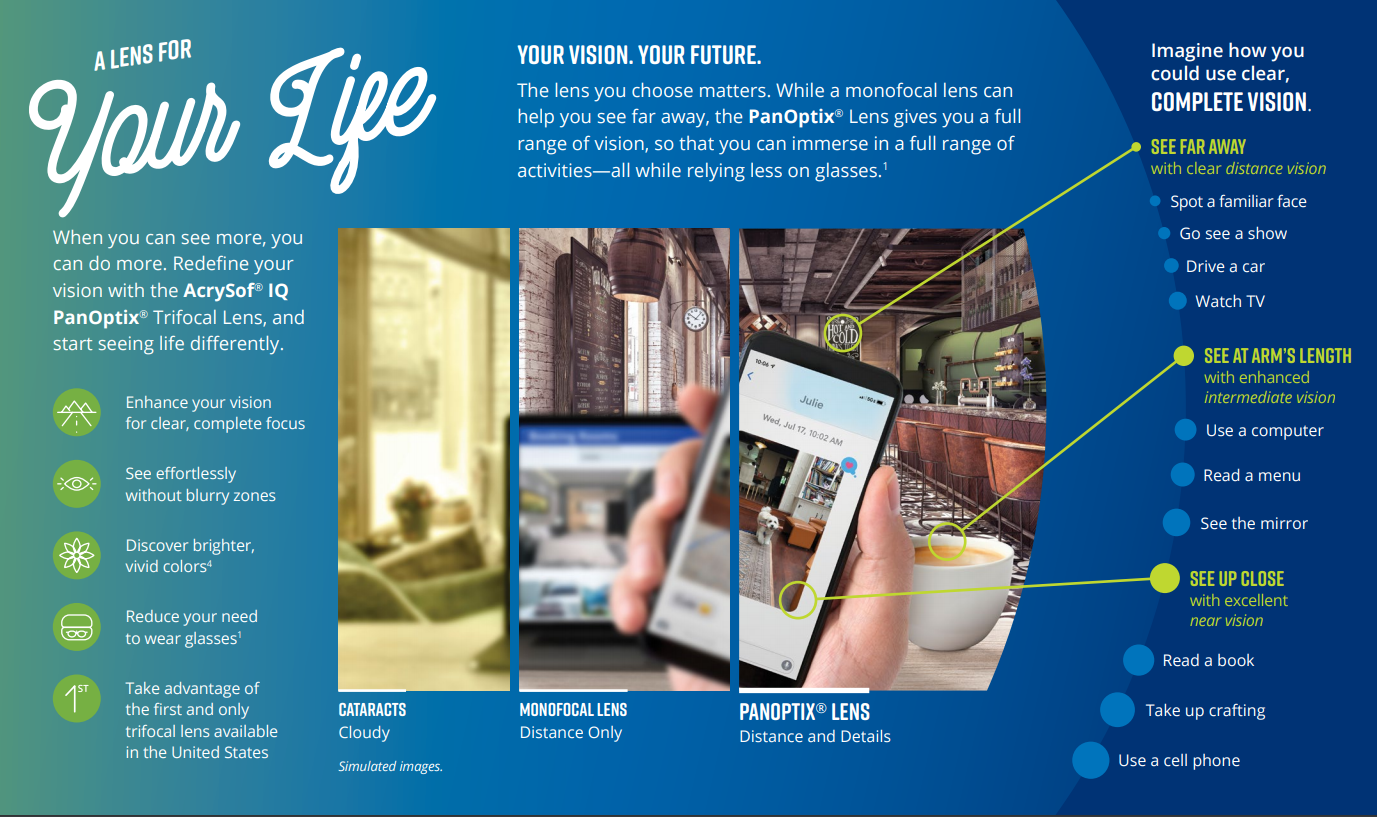Presbyopia is the inability to focus on close objects and usually requires bifocals or reading glasses. You can go on hassling with these types of eyewear after surgery — or you can gain independence from glasses when you receive PanOptix® premium IOL implants. You’ll be able to switch between reading up close and seeing the TV with little difficulty, and without having to put on glasses.
Multifocal (also known as accommodative) IOLs reduce the likelihood that you will be required to wear glasses or contacts after surgery. Multifocal lenses incorporate both distance and near powered lenses into one lens. The lower power zones bend light coming from distance objects to a single focal point on the retina. The higher power zones bend light from near objects to the same focal point on the retina. Thus, different zones of lens power work together to provide the eye with near and distance vision.
Acrysof® IQ PanOptix® Trifocal IOL Implants
 Advances in IOL (intraocular lens) implants have given cataract surgery patients more options after surgery. Life after cataract surgery used to always require glasses since lenses only gave patients good distance vision. Now, new options for better vision after cataract surgery have been created including the AcrySof® IQ PanOptix® IOL.
Advances in IOL (intraocular lens) implants have given cataract surgery patients more options after surgery. Life after cataract surgery used to always require glasses since lenses only gave patients good distance vision. Now, new options for better vision after cataract surgery have been created including the AcrySof® IQ PanOptix® IOL.
The AcrySof® IQ PanOptix® IOL is a unique lens that provides patients with quality vision including near, far and intermediate distances. Many patients who have had this lens implant do not need to rely on their glasses or bifocals after cataract surgery. The AcrySof® IQ PanOptix® IOL is the first and only trifocal lens in the United States.
How does the AcrySof® IQ PanOptix® Trifocal IOL work?
As we age our eyes lose their ability to change focus and adjust from viewing something far away, like driving, to something up close, like reading a newspaper. This ability to focus is called accommodation. The AcrySof® IQ PanOptix® IOL has the ability to help patients see both near and far without depending on reading glasses.

Is the AcrySof® IQ PanOptix® Trifocal IOL lens right for me?
If you are a cataract patient who will have to rely on reading glasses or bifocals after your cataract surgery, you may be a candidate for the AcrySof® IQ PanOptix® IOL. It is important that you speak with your surgeon or a member of our Cataract Surgery Team to determine your vision expectations after cataract surgery.

AcrySof® IQ Vivity® IOL Lens Implants
The AcrySof® IQ Vivity® IOL is a presbyopia-correcting non-diffractive extended vision intraocular lens that provides cataract patients with a continuous range of vision after cataract surgery.
Innovative X-WAVE™ technology separates the AcrySof® IQ Vivity® IOL lens from other intraocular lenses currently on the market by providing an extended range of vision and providing patients a reduced need for glasses. The unique non-diffractive design means that light is not split to create multiple focal points, allowing patients to enjoy an extended range IOL with a halo and glare profile comparable to a monofocal IOL.
Monofocal Lens |
AcrySof® IQ Vivity® IOL |
 |
 |
The simulated images above are for illustrative purposes only. Patients should exercise caution while driving at night.
The AcrySof® IQ Vivity® IOL Improves Both Quality And Range Of Vision
With the AcrySof® IQ Vivity® IOL, you can expect a continuous range of vision for distant and intermediate tasks, while also providing you with functional near vision. Functional near vision reduces your need for glasses when performing up-close tasks such as using your smartphone or reading a menu in adequate light, compared to a basic monofocal intraocular lens which doesn’t address presbyopia. The technology in the AcrySof® IQ Vivity® IOL supports your vision in low light through its extended range of vision and reduction of monofocal-like visual disturbances like halos and glare. The need for reading glasses when performing up-close tasks, such as using your smartphone or reading a menu in adequate light, is reduced compared to basic monofocal intraocular lenses because of the near functional vision of AcrySof® IQ Vivity®.

AcrySof® IQ Vivity® IOL Can Reduce the Need for Glasses
AcrySof® IQ Vivity® lOLs make it easier to see intermediate and far distance tasks while providing functional near vision for tasks such as using your smartphone or reading in natural light, reducing your need for glasses. You may find that detailed tasks like reading fine print, are improved with wearing glasses or by adjusting the font size adjustments or zoom functions on your smart phones or devices.
What to Expect After Surgery
For many patients, lasting vision and the confidence their sight will not undergo major changes following cataract surgery is just as important as removing their cataracts. Ask your eye surgeon how to care for your eyes after surgery, when you can return to your normal activities, and what to watch for (including signs that you should contact your surgeon). The amount of time it takes to adjust to new lenses after cataract surgery can vary by individual. You will have a follow-up appointment a day or two after your surgery. It is unlikely your vision will change significantly in the years following your cataract surgery.
Have your vision and eye health tested:
• At least every 2 years if you are under 65
• At least annually if you are 65 and over
• If you notice any changes in your vision
As with any surgery, be sure to speak with your eye doctor about all of the risks associated with cataract surgery.
Vision Plans and Insurance
Our surgical coordinators will work with you to discuss your coverage and payment options. For example most Medicare supplemental insurance and private insurance policies cover cataract surgery, but there is an additional fee for premium IOL implants and LCS.









